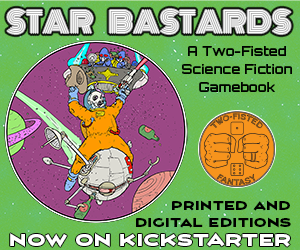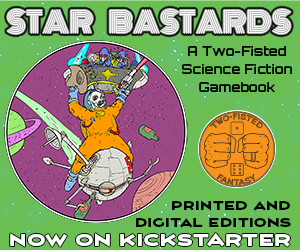
Star Bastards
Star Bastards is an adventure gamebook, being funded via Kickstarter, by Hermit Skull.
Sam Iacob

Back the Star Bastards Kickstarter here
Welcome to the latest Designer’s Diary, a column where designers are given the opportunity to take readers on an in-depth ride through the design and development process of their system, setting, or product. If you’d like to share your product in the Designer’s Diary column, send a message to aaron@roleplayerschronicle.com.
Designer’s Description
Star Bastards is a sci-fi gamebook adventure set in deep space. It’s really two adventures in one – you can play as the Space Exploration Pole who’s fallen afoul of the law, or as the interstellar cop tasked with bringing him in. It’s a high-speed chase across a bunch of derelict star systems in a dangerous galactic backwater, packed with treacherous aliens, scenic locations and difficult puzzles. It’s 400 sections long, 100,000 words and includes 8 major endings, allowing you plenty of ways to punch, shoot, sleaze or sneak over the line to freedom (or, if you’re the cop, a big promotion).
Purpose
I started working on Star Bastards with the intention of testing out the systems I was planning to use in a bigger game that I was working on at the time. It was going to be a quick, 120 paragraph adventure but I realised there was more than enough going on here to make it a full-fledged book so I changed my plans. Also, I’ve written a couple of forums-based Choose Your Own Adventures which were designed to look as though I’d found an old, unknown gamebook series called “Two-Fisted Fantasy”. Sword of the Bastard Elf and Void Racers were really well received and they were actually run using the game mechanics I’d invented for them, so I figured it was time to write an actual Two-Fisted Fantasy at last.
Influences
From the beginning and most obviously the Fighting Fantasy series, from which I borrowed the familiar 400-section layout, full-page black and white illustrations and the instructions at the front of the book. This is a classic chase story so there’s not a lot of space for it, but in everything I write there are political overtones – while the characters and jokes can be silly they’re all living in a universe where something bigger is going on. I think this gives the stories a lot of solidity while still allowing for plenty of sci-fi and fantasy antics and I think makes things more interesting (I also appreciated Babylon 5 for that reason). This all comes from several years buried in political and history books for various courses. The humour of the Something Awful forums also plays a big part – while working on Star Bastards I often thought, “what would the Goons (the name for the forums posters) want to do here?” Finally, there are a bunch of stupid puns and lots of offhand references to music, movies and other games which will probably be obvious when you run into them.
Research
As I began working through the design phase, I got a lot of inspiration from gamebook blogs like Lloyd of Gamebooks – the site is run by a fellow who has written a whole bunch of gamebooks and he’s always updating with useful information and links for designers. I played through a bunch of Fighting Fantasy books and apps, paying particular attention to Starship Traveller because of its setting and the interesting multi-crew mechanic. I watched a lot of sci-fi too and a bunch of chase movies. I also spent a lot of time crawling over astronomy blogs and webpages to find names for the star systems and places in the games, and to make sure the planets I was describing were within the realms of plausibility, even if the science isn’t discussed much in the book. I also had to find out how to write a whole lot of Polish words and phrases: if you play as the Polish Explorer, he doesn’t speak English and the interstellar translators haven’t figured out Polish, which leads to some fun situations in the game.
Art Direction
I wanted the pictures to be action-packed (this is a chase story after all) but still have a lot of interesting detail. The idea I wanted to get across is that this chunk of the universe is populated by a group of aliens who have their own thing going on – they haven’t just been waiting for you to come along. There’s a lot of detail packed into the full-page illustrations and some of it should provide some laughs. Likewise characters and items that you can bring along are designed to be interesting and expand the universe a bit just in their card graphics. For instance, most of the alien currency cards aren’t money – one’s some kind of internal organ in a clear container, and the health packs are disposable miniature droids who trundle around after you to provide emergency medical care. The cover gives you an idea of the sort of thing you might expect.
Gaming Experience
It’s a single player gamebook with two separate adventures. Since each adventure is 200 paragraphs long a single playing session won’t take you all that much time, but the situation changes based on how fast you’re moving and your co-pilots and item choices can massively influence events, so there’s a lot of replayability. Combat is relatively simple, relying on only a couple of stats, but manages to give you a lot to think about. As a space hero you’re usually very powerful compared to your opponents, so you can often steamroll them at the risk of wasting valuable energy, or you can choose to risk combat dragging on and injuries piling up, but save your energy for the next challenge. There are some surprisingly tricky puzzles to solve as well. The text is lively and funny and generally everything whips along at a cracking pace until you either win or come to some sticky end out there in the dead of space.
Comparison
The most obvious difference is the cards – rather than detail the effects of items and co-pilots in the text, all the information you need is on the cards. You can just place a card in front of you when playing instead of writing it on the adventure sheet. It adds a lot of flexibility and helps immerse you in the game a lot more. These are available for digital and physical versions but in a pinch you can refer to the item table at the back of the book (for the e-book edition all items are linked to this table since if you’re playing on a Kindle you probably won’t have cards or a spare screen to hand).
Compared to most books of this type the paragraphs are longer. The combat and skill testing system is unique but not particularly complicated, and strikes a nice balance between simplicity and an overabundance of options – you will have an important decision to make every round of combat. There are a pile of little quality of life improvements I made as well – the digital and e-book versions are hyperlinked throughout (and the e-book version has modified section entries to make it easier to move around secret entries and puzzles by searching rather than scrolling), the digital deck of cards is bookmarked and it comes with a quick reference document with printable adventure sheet.
Unlike most books of this type there aren’t any important decisions that you’ll have to take blind – you’ll find clues about the right or wrong course of action in any particular scenario and you’re not going to be locked out of a win because you went left instead of right at the first planet.
Development Process
I started with concept drawings, sketches and brief descriptions of the setting and characters and from there moved on to a branching decision chart for each character in each of the systems in the book. I then wrote the text for each spot on the decision chart – 400 sections in total – and then scrambled the paragraphs. At this point I ran the first Kickstarter for this project – a digital only book with a high target because I wanted to pay an illustrator to draw all the art for one of the character branches. Unfortunately that didn’t take off and I continued work on the book alone. I then did the layout, identified the paragraphs that needed an illustration and did all 32 illustrations and the pile of interstitial graphics. Finally, I illustrated and refined the effects for the item cards based on feedback from test players, got everything printed and started this second Kickstarter, which has been really successful. The stretch goals have seen development continue – there’s now an ebook edition, colourised cards are in the works and a few other bits and pieces coming up that I hope players find interesting and useful at any pledge level.


